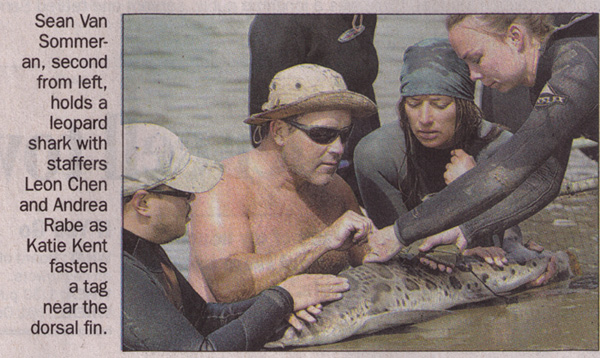 | |||||||||||
|
|
|
|
|
|
|
||||||
|
| |||||||||||
June 19, 2007Sharks, rays thrive in Elkhorn Slough's muddy waters
MOSS LANDING - It seems an unlikely place to catch leopard sharks and bat rays, but the smaller channels of Elkhorn Slough were crawling with them Monday as the Earthwatch Institute teamed with the Pelagic Shark Research Foundation to catch, tag, then release them back into the murky waters.
Nearly two dozen fish were trapped inside the large and unwieldy nets in less than three hours, all part of a long-term monitoring program designed to further research while promoting species conservation in the shadows of the Moss Landing power plant.
"This place is a mating factory," said Sean Van Sommeran, executive director of the Santa Cruz-based research foundation. "We've caught a lot of juveniles and pregnant females. We once saw a guitar fish give birth in one of our holding pens a few years back, so we know that this place is a critical reproductive habitat" That the muddy waters of Elkhorn Slough contain reproductive species is good news. There was a time when the tidal wetlands were nothing but dry ground, an expansive field used for grazing until the early 1980s, when a concrete channel was built three miles from the Monterey Bay, allowing in more water from the Pacific Ocean. So abundant were the sharks and rays afterward that archery contests were held for years, featuring guys who would hunt the fish with bows and arrows during low tide, awarding prizes to those who killed the most. Such gamesmanship began to take its toll, however, and Van Sommeran, with the help of other environmental groups, helped put a stop to the killings in 1996. "The slough is making a comeback. The tide is re-establishing itself," said Van Sommeran, a 1981 graduate of Santa Cruz High School who's been monitoring the slough with his small staff. They're a bunch of volunteers who hold science degrees from various universities and work odd jobs when they're not out in the slough, setting up the nets and wrestling with the sort of fish that would ordinarily scare the bejesus out of most folks. There's Josh Leader, a park ranger at Loch Lomond in the Santa Cruz Mountains; Andrea Rabe, a pro surfer and biochemist; Leon Chen, a recent graduate of UC Santa Cruz and a former Google employee; and Katie Kent, a recent graduate of Monterey Peninsula College. On the surface, the program may seem to come across as mere animal lovers having a lot of fun and "Huckleberrying" around, Van Sommeran said. Look beneath the surface, however, and what you've got is the epitome of a "hands-on, outdoor science project" that has existed for more than a decade. An amazing number of discoveries have been made - "and not the academic kind just for academic sake," he said. For starters, the tissues they collect from the fins of each fish are sent to the U.S. Fish and Wildlife forensics lab in Oregon, which records the DNA and has something to refer to for law enforcement purposes in the event of an unlawful take. Also, if some leopard shark from the slough should show up in, say, the middle of the ocean, the San Francisco Bay or off the Channel Islands in Southern California, researchers have that on record, too. But the research is much more than just keeping tabs on wayward migrations. It's also about letting the general public know about certain things, like how some of the leopard sharks in the slough have been found to have heavy levels of contaminants due to pesticide use in the region - both past and present, Van Sommeran said. And for some, it is fun to become one with nature, which is how the Massachusetts-based Earthwatch Institute is helping fund part of this year's shark population count. It recruited ordinary citizens to spend more than a week with Van Sommeran and staff for $2,500 per person. Jack and Debbie Eastburn, for example, came from Palo Alto to participate in Monday's event. "It kind of feels like sandpaper or maybe skateboard tape," Jack Eastburn, 17, referring to the texture of the thornback ray, said after he stepped on one the other day, then fished it from the net. Molly Weisman, a Chicago native, is another one, although she didn't pay for the expedition out of her own pocket. She earned a fellowship. "I needed to get over my fear of sharks," said Weisman, an urban planning major at the University of Illinois at Urbana. "And this seemed like a good place to do it" Contact Tom Ragan at tragan@santacruzsentinel.com. Pelagic Shark Research FoundationWHERE: Based at Santa Cruz harbor.Founded: 1990.Mission: To conserve sharks and rays and educate the public. Contact: 459-9346 or www.pelagic.org
You can find this story online at: http://www.santacruzsentinel.com/archive/2007/June/19/local/stories/02local.htm
Copyright © Santa Cruz Sentinel. All rights reserved.
|
||||||||
Back to Pelagic in the News |
||||||||
| ||||||||

